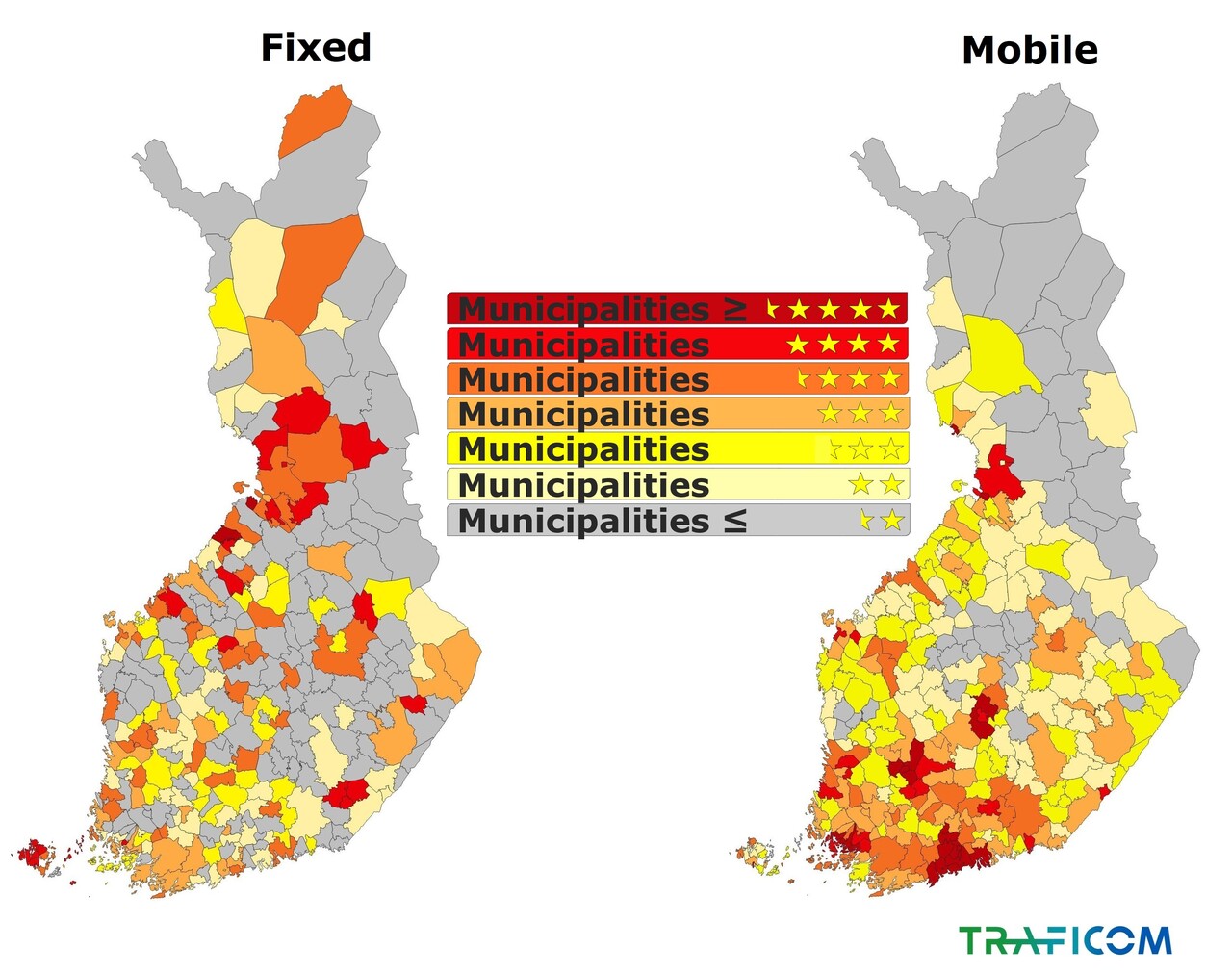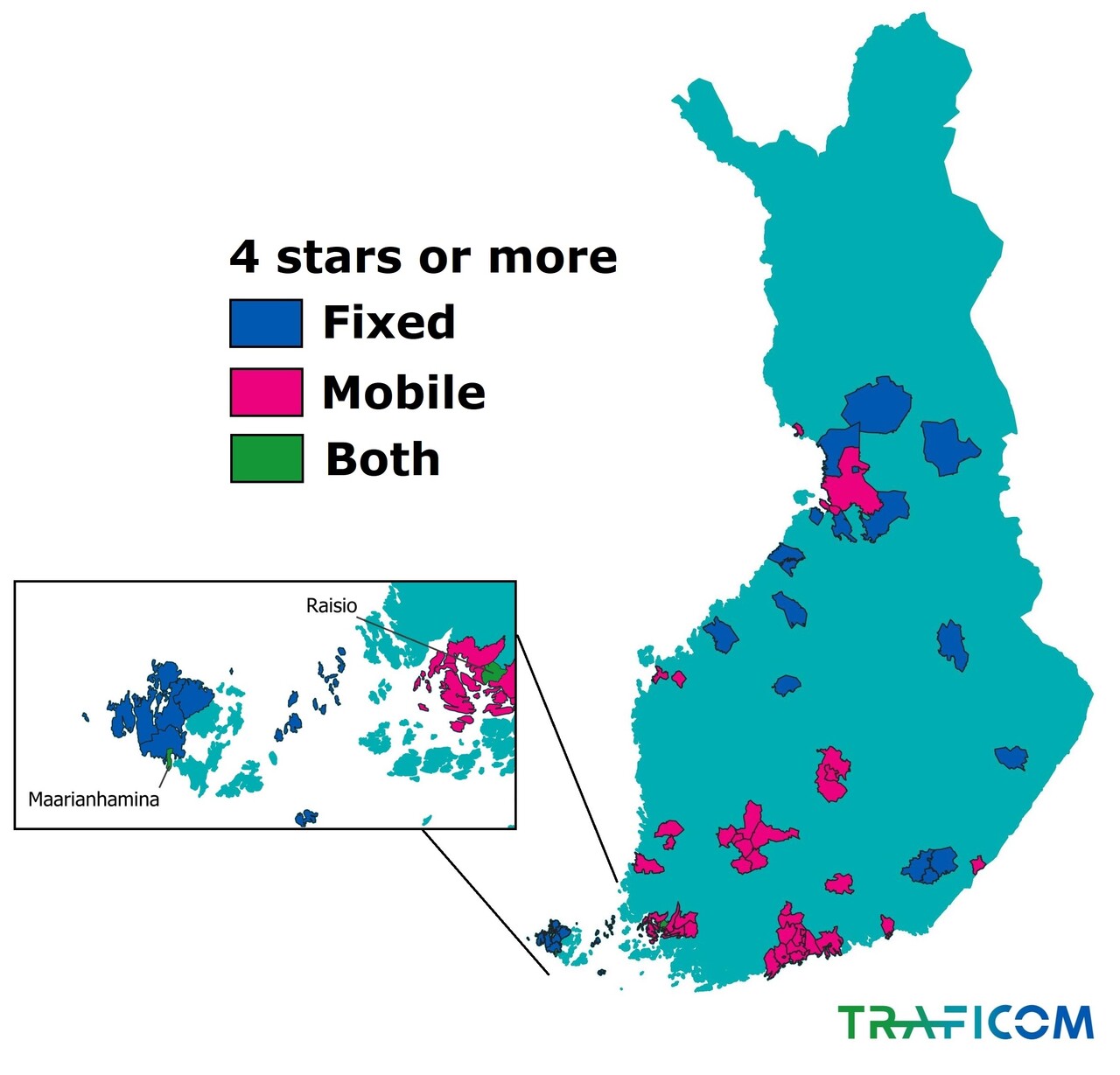Digitalisation is progressing in Finland, but there are significant regional differences in the availability and deployment of internet connections. As the services are moving online, all municipalities need well-working broadband connections both within and outside the home. With good connections, the municipality can ensure that remote work, remote services, the environmental solutions brought by digitalisation, the digital services used by companies and future solutions, such as smart transport and virtual reality, among other things, are available to its residents.
In order to illustrate the regional comparison, the Finnish Transport and Communications Agency Traficom has created a municipality-specific broadband rating. The star rating has been given separately for the situation of both fixed and mobile connections. The rating has been calculated with the aim of describing both the current situation as well as the ability to meet future needs. Each municipality receives stars separately for both the fixed and the mobile broadband on a scale from 1 to 5. The calculation of the rating is described in more detail at the end of the news.
In smaller municipalities, fixed connections are largely built by cooperatives
Fast fixed connections are being built at a steady rate, especially outside the largest cities when considered in proportion to the number of inhabitants. Lumijoki and Pyhäjoki gained the highest star rating at 4.5 stars. As many as 27 Finnish municipalities received at least 4 stars, which is 8% of all municipalities. In the rating, 4 stars already means that the availability and deployment of fast fixed connections is at a very good level. During the year, new fast broadband has been built especially in places such as Lappajärvi, Nivala, Oulainen and Raahe, the rating of which rose clearly from the last year.
In many respects, the success of smaller municipalities with fixed networks is due to the active optical fibre cooperatives that have built regional optical fibre networks with the help of state aid for broadband, for example. The aid is granted to areas where market-based broadband connections are not developing quickly enough, and the mobile network cannot offer sufficient connections, either. The municipalities in the leading areas have played an active role in supporting the construction of optical fibre networks.
The star rating of the mobile network shows the construction of the 5G network
The 5G network has been built first in urban areas in particular. A total of 10 municipalities get the full 5 stars in the mobile network rating. The coverage of fast 300 Mb connections offered by 5G in particular raises the number of stars for these municipalities. As many as 40 municipalities received at least 4 stars. Most of these municipalities consist of larger cities and the clusters of habitation surrounding them. The star ratings are calculated based on the theoretically available coverage.


As digitalisation covers more and more aspects of life, connections of sufficiently high quality are increasingly important to municipalities. However, 40% of Finnish municipalities still remain under 2 stars with regard to the fixed network. For the mobile network, there are fewer municipalities under 2 stars; less than one fifth of the Finnish municipalities. Attention should be paid to sufficient connections especially in the areas where there are few connections of any kind available, fixed or mobile – 23 municipalities remain under 2 stars for both.
Calculating the broadband rating
In the fixed connection rating, municipalities receive 1–5 stars depending on how easily the households in the municipality can get fixed broadband connections that enable both the current and future services (decreasing speed at least 100 Mbit/s) and how many faster connections the consumers have adopted (connections of at least 30 Mbit/s). To reach 5 stars, nearly all households in the municipality must have a 100 Mb connection available.
The rating of mobile connections focuses on the main feature of mobile connections, meaning their use outside buildings. In addition, the 300 Mb coverage is taken into account separately, because the maximum speed of the mobile network can rarely be achieved in practice. This means that the calculation emphasises the coverage of 100 Mb and 30 Mb on the road, but it also takes the 100 Mb and 300 Mb household coverages into account. To reach 5 stars, the municipality must have a comprehensive 100 Mb coverage on the road and an extensive 300 Mb household coverage.
Additional information
You can find more details in the Monitori service (External link).
The star ratings can also be downloaded as a table (External link) (ods, in Finnish). You can also find more information on how the rating is calculated.
Information on the availability of the fixed and mobile networks by municipality and region for 2020.
Previously published news on the star rating:
Elina Pallas, Senior Specialist, tel. +358 295 390 126, elina.pallas@traficom.fi
Joonas Sotaniemi, Communications Market Specialist, tel. +358 295 390 309, joonas.sotaniemi@traficom.fi